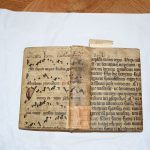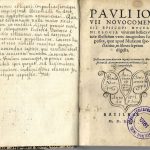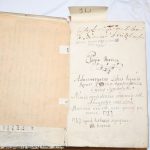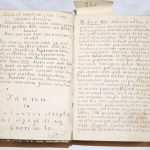On April 10, 1910 Imre Hauser – at the time theology student, later priest and military chaplain on the Russian and Italian fronts during World War I – transcribed some of the text preserved on the fragment. The paper containing the transcription was glued to the inside of the book with paper tape. 4 double sheets of paper were bound to the inside front cover, the first page serving as pastedown. Two names are recorded on the second page (Gyula Wajdits, Árpád Szabó) with the date March 30, 1899. Further below: Elogica Heroica, Adnumerantur libris Ioannis Kovats Pestino-Apostagiensis (…). According to the Hungarian Catholic Lexicon Gyula Wajdits was a spiritual of the Pécs Seminary from 1899 to 1902 (cf. http://lexikon.katolikus.hu/W/Wajdits.html). On pages 3-8 parts from the biography of István Szegedi Kis by Máté Skaricza are noted (Tantum ex universo Stephani Szegediny Curriculo).
The fragment contains parts from the office of St. Sophia: two antiphons and a lesson from the Matins. Based on the antiphons’ modal assignment, on their melodies and on the psalm (Quare fremuerunt) of the first antiphon, it is clear, that they are parts of a historia following the modal order, more precisely, they represent the second and third antiphon of the first Nocturn. In late medieval Hungary the cult of the fictitious figures of Sophia, her three daughters (Fides, Spes, Charitas), and their martyrdom was primarily rooted in the folk tradition. The official liturgical books rarely commemorate the saint’s feast on the 15th of May, and the number of sources containing a historia propria for Sophia is even lesser. The historia Sancta praeconia recolentes, partly preserved on the fragment, occurs in only three breviaries, according to our current knowledge: Breviarium, Alba Iulia Biblioteca Batthyaneum, R. I. 110; Diurnale, Alba Iulia Biblioteca Batthyaneum, R. II. 125; Breviarium ex Bártfa / Bardejov, Hungarian National Museum 63.74.I.C. (cf. Andrea Kovács ed., Corpus Antiphonalium Officii Ecclesiarum Centralis Europae V/B Esztergom / Strigonium (Sanctorale. HAS Institute for Musicology, Budapest, 2006, 210–211, 286–287). Based on the liturgical content and the musical notation it is likely that the original mother codex was used in the northern areas of medieval Hungary. The fragment is of particular interest for the study of late medieval plainchant in Central Europe, since it represents the only known musical source of the historia of St. Sophia.
Zsuzsa Czagány





